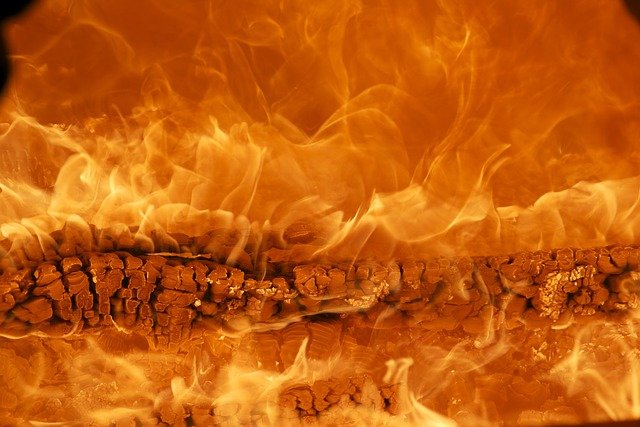
Intumescent strips, or intumescent seals, are an important part of fire door safety and play a vital role in fire protection.
Together with a fire door frame and the correct fire door hinges, intumescent strips contribute to the fire protection levels of the door, helping to prevent smoke, heat and flames from spreading. This gives occupants more time to safely exit the building and helps to prevent damage to the property.

Intumescent seals or strips are also known as fire door seals. When fitted correctly to a certified fire door, intumescent seals are designed to expand and fill the gaps between a fire door leaf and the frame.
On a normal day-to-day basis, a fire door will have a small gap between the door and the frame, to allow it to open and close with ease. Intumescent strips surrounding the fire door will expand with heat and effectively hold the door into its frame.
An intumescent material is one that swells up when exposed to heat: the heat from the fire reacts with the seal material, such as sodium silicate or graphite. A fire will reach around 200 degrees within 10-15 minutes of starting and it’s at this point that the intumescent strips will expand. This helps to prevent the fire from spreading through the door to other areas.
As with any type of fire door, they should always be kept closed when not in use. This ensures that if a fire does start in any part of the building, fire doors will be in place and ready to restrict the spread.

If Building Regulations for the property in question dictate that fire doors are required, then intumescent strips will usually be needed. Different fire doors provide a certain length of protection from heat and flames. For example, a standard FD30 fire door will offer 30 minutes of protection, whereas a FD60 door (usually used in commercial premises) will withstand a fire for 60 minutes.
Adding an intumescent seal to a standard door does not generally make this a fire door. A fire door will still need the certified hardware, hinges and fire-rated frame in order to pass a fire safety inspection. Older-style panel doors (particularly if less than 44mm thick) are unlikely to be fire rated. Similarly, hollow doors will also not meet the minimum FD30 standards, even with fire seals installed.
Fire doors are typically required for:
While most fire doors will need intumescent strips to pass a fire safety inspection, some fire doors will also need smoke seals depending on the type of property they are used for and where they are in the building.
Check the local building regulations for your area and type of property to ensure that you are adhering to fire safety regulations.
Smoke inhalation is more likely to kill the inhabitants of a building than the fire itself. Smoke inhalation can cause loss of consciousness meaning that occupants cannot safely exit the building or raise the alarm.
While an intumescent strip will delay a fire from spreading, it may not be effective at stopping the spread of smoke unless it is also fitted with a smoke seal. Some types of fire door (for certain properties) will require smoke seals as well as intumescent strips to guard against smoke leakage. These types of fire doors are rated as such, for example FD30S, rather than just FD30.
Fire seals and smoke seals are different (although there are products available which combine the two functions). They must be compatible with the fire door and there are different seals to use on single or double door leaves.
When a fire seal is exposed to extreme heat, the intumescent material expands and seals the gap between the door and the frame, effectively blocking the fire. During everyday use, they are not active or visible, and do not affect the ability of the door.
However smoke seals work by sealing the gap around the fire door, connecting the door leaf and frame. They can be fitted to the door stop so that it connects with the front of the door, or fitted in the leaf edge or around the frame. Smoke seals can usually be visible, although they are discreet and do not affect the performance of the fire door.
Smoke can cause fire damage to the building as well as adding to the risk of death or injury. Fire doors which also require smoke protection will control the leakage of smoke around the gap of the door. When fitted correctly, the intumescent seals and smoke seals can help prevent damage and allow more time for the fire brigade to arrive at the property.
As well as ensuring a good standard of fire safety protection, door seals also have added benefits such as keeping out drafts and reducing noise transmission, which is ideal for public buildings such as offices, hospitals and schools.

Intumescent strips should always be fitted by a competent professional, such as a certified carpenter or joiner working under the Accredited Fire Door Installers Scheme.
Once the fire door has been installed, you should perform regular maintenance checks to make sure it is working correctly. If there are visible gaps (larger than 3mm) around an existing fire door leaf, then it could be that you need to replace the seals or the door set.
RELATED: When to replace a fire door
You should also check the relevant Buildings Regulations in your area to see if any other types of door seals are required for the property.
If you are responsible for a public building then it’s important to carry out a fire risk assessment and comply with fire safety regulations. You can find out how to book a fire safety inspection by contacting your local council or fire brigade service.
Proud stockists of....
